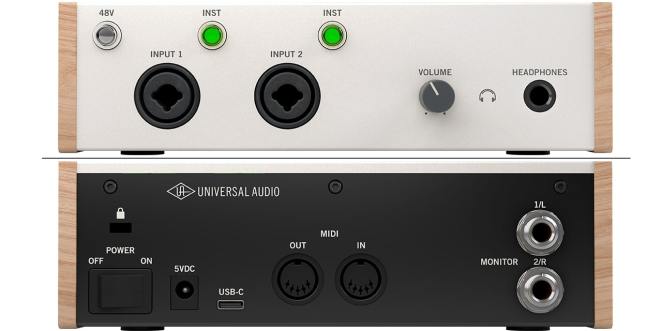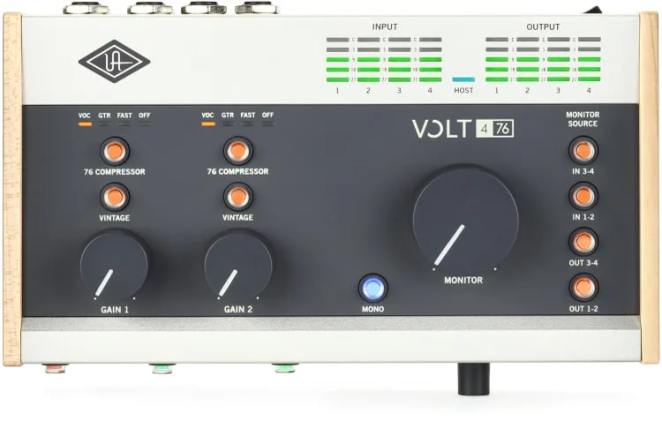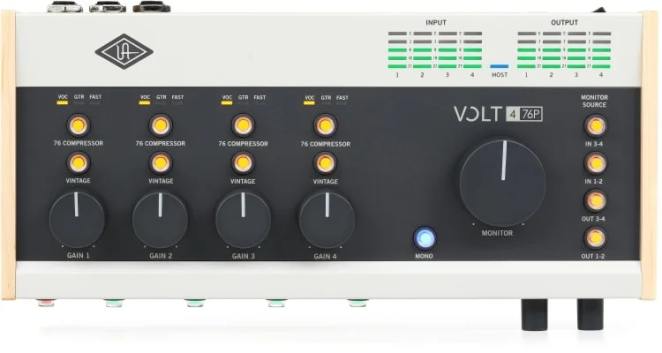When you buy through our links, we may earn an affiliate commission.
Finding the perfect audio interface is as challenging as it gets. To find the right one for you, you have to consider dozens of factors, ranging from I/O capabilities to overall sound quality.
But what if I told you that there's a budget USB interface that's built to fit every need of a home studio enthusiast? Cue in the Universal Audio Volt 276 — a flexible audio interface that packs a true powerhouse without leaving behind looks and affordability.
If you're looking for an audio interface that can handle pretty much any instrument while also printing a pleasing vintage tone onto your tracks, then this is the perfect pick for you.
Here is my honest Universal Audio Volt review — let's find out if it's the right choice for you.
Universal Audio Volt 276: Our Take

The Universal Audio Volt 276 is hard to beat for its price. Top-notch analog circuitry, crystalline audio conversion, and versatile (yet minimalist) I/O are the name of the game with this one.
At first glance, the Volt 276 may seem rather... simplistic. But beneath this sleek, vintage aesthetic lies a true powerhouse USB audio interface that will allow you to capture every drop of creativity. With two mic and line inputs, stereo monitor outputs, and a headphone jack, the 276 is all a home studio producer needs.
When I compared this to other similarly-priced audio interfaces, such as the Focusrite Scarlett 2i2, I found that the 276 gains the edge thanks to its sound sweeteners. Both inputs come equipped with an 1176-derived FET compressor and a vintage preamp that gives your sound that extra color.
Throw in a top-of-the-line 24-bit 192kHz analog to digital conversion and you can forget about noisy, low-quality recordings. Just plug in your favorite instruments and let the Volt 276 do the rest!
But I get it — not everything has to do with raw specs when it comes to buying audio interfaces. The cool vintage look will fit right into any desk without sacrificing stylish metering and heavy knobs. And, of course, the compact format will make sure you don't miss out on any space for your other gadgets.
Why I Like It:
- Spectacular aesthetic
- Top-notch recording quality
- Integrated compressor and preamp
- Versatile I/O
What I Think Could Be Improved:
- Compressor can be a bit noisy
Features of the Universal Audio Volt 276

Although the Volt 276 may seem a bit small, it comes packed with dozens of features to fit every producer's needs. All this info may be a bit daunting for beginners, so I thought it was essential to break it all down into simpler terms for our Universal Audio Volt review. Here's what you need to know:
I/O capabilities - 5.0
It's hard to fit all the necessary inputs and outputs on such a small piece of equipment, but Universal Audio did its job. At its core, the 276 comes with two mic or line inputs that are more than enough to capture any instrument — including phantom-powered microphones.
Alongside these inputs is the headphone output, which is also capable of direct monitoring. On the back, you'll find two monitor jacks to plug in your favorite speakers. And, naturally, the MIDI in/out jacks are more than appreciated at this price point.
Recording quality - 5.0
We can't write a Universal Audio Volt review without mentioning... well, audio quality. And I can confidently say that the 276 doesn't disappoint: with a 24-bit/196kHz resolution, this tiny powerhouse can handle anything with crystal-clear precision.
Forget about noisy recordings and opaque takes — the analog circuitry is built to deliver pristine audio in pretty much any situation. And, naturally, the zero-latency direct monitoring ensures you can listen to your instruments in real time without interference.
Sound sweeteners - 4.5
It's not uncommon for modern audio interfaces to come equipped with what's called "sound sweeteners:" usually analog preamps, compressors, and limiters. As we already mentioned, the Volt 276 is no exception to this — and boy does its vintage mode deliver.
Each input comes equipped with a classic 610 tube preamp that's known to add warmth, low-end, and even a subtle grit to any instrument. And if that weren't enough, they also feature an 1176-derived FET compressor with three switchable modes to take your recordings to a whole new level.
The only downside is that the compressor can be a bit noisy at times, but you can always turn it off if it's not getting along with one of your instruments.
Build quality - 4.0
The Volt 276 is built to last for years to come — and you can tell simply by its looks. Featuring an almost completely metal construction, the 276 can handle touring musicians and home studio enthusiasts alike. The team at Audio Universal even claims that it can last for decades!
We can attest to the sturdiness of the 276, but I would've liked it to feel a bit more substantial. Coming in at a bit less than two pounds, anyone can agree that the Universal Audio 276 is a bit too light — even if you're not planning on moving it around that much.
Other Universal Audio Volt Versions
You may've noticed that the 276 isn't completely on its own. To accommodate any producer's needs, the team at Universal Audio has released three other Volt interfaces, which mostly vary when it comes to I/O:
Universal Audio Volt 176

The Volt 176 is pretty much the same as the 276, with the slight difference that it only has one line and mic input. Of course, this means that the box will only include one XLR-1/4" TRS cable and that the interface itself will have one input level knob.
But it's not all downsides — the lack of that second input reduces its price by almost half of that of the 276. The 176 might be the better option for you if you're either running very short on budget or you're just starting out recording music.
Universal Audio Volt 476

On the other hand, the Universal Audio Volt 476 comes equipped with four mic and line inputs instead of two. Out of these four, two feature the 610 tube preamp while the other two are your usual non-sweetened inputs. And, if that weren't enough, there are also four outputs instead of two.
While the 476 is a bit more expensive than both the 276 and the 176, it might be worth it if you're an experienced producer and multi-instrumentalist. Or, if you're looking to record entire bands and rehearsals!
Universal Audio Volt 476p

Much like the above-mentioned 476, the Volt 476p features four inputs and four outputs. But the key difference is that the 476p provides a 610 tube preamp for each of the four inputs, making it a more versatile option if you're recording multiple instruments at once.
It's worth noting that this seemingly subtle contrast significantly increases the price — but it might be the right choice if you're after that vintage mode.
Things I Consider Before Buying an Interface
If it's your first time buying an audio interface, making a final decision can be a tough call. There are a lot of factors to consider, and it's easy to get lost in the hundreds of options available on the market. So, how do you know if the Universal Audio Volt (or any of the other Volt audio interfaces) is the right interface for you?
The main thing to keep in mind when buying a 276 is that it's a home studio interface. If you're looking to set up a professional studio for recording entire bands, you should look at other options with more I/O. But if you need a way to record your instruments one or two at a time from the comfort of your own home, then the 276 is the perfect choice for you!
Here are three key questions you should ask yourself before buying a Volt 276:
- Do I need more than two outputs and two inputs?
- Can I skip on the vintage preamp and compressor?
- Am I looking for 32-bit resolution?
If the answer to any of these questions is yes, you might be better off buying another audio interface. But as long as the features of the Volt audio interfaces fit your needs, you'll find that there are very few products that come close to it in terms of quality and cost.
Alternatives to the Universal Audio Volt 276
The market for affordable USB interfaces is growing stronger by the day. This can make it a bit challenging to find the right interface for you, and decision paralysis is common among amateur producers. Here I'll compare the Volt 276 to some of its competitors to help you find the right choice:
Universal Audio Volt 276 vs Focusrite Scarlett 2i2
The Focusrite Scarlett 2i2 is, quite possibly, the most fierce competitor to the Volt 276. While these two are quite similar to each other, the key difference is that the Scarlett 2i2 doesn't come with a vintage compressor. Instead, it provides a modern limiter and preamp.
This makes it better suited for music producers who are looking for a more contemporary, high-end heavy sound. The Volt 276 is, on the other hand, more appropriate for vintage tones with a dense low-end and a slight grit. Check out our review of the Scarlett range to learn more.
Universal Audio Volt 276 vs Solid State Logic SSL2+
The similarly-priced Solid State Logic SSL2+ is another great alternative to the Volt 276. Featuring four monitor outputs and a pair of headphone jacks, the SSL2+ is a bit more versatile in terms of I/O — but at the expense of sound sweeteners and looks.
Unlike the Volt 276, the SSL2+ doesn't feature an onboard compressor, instead offering a "Legacy 4K" mode that activates the integrated mic preamps. Naturally, these won't sound as warm as the 276, but the SSL2+ may be a great option for you if you're not after a vintage tone.
Universal Audio Volt 276 vs Audient iD4 MKII
Another great budget option is the Audient iD4 MKII, which has a lower price tag than the Volt 276. But, unlike the latter, the Audient iD4 MKII only provides one mic and line input, with a second input jack that can only handle line.
This makes it a rather lacking option for most home studio enthusiasts — although it may still be a great choice for you if you're tracking one instrument at a time.
Universal Audio Volt 276 vs Native Instruments Komplete Audio 6 Mk2
There's no denying that the Native Instruments Komplete Audio 6 Mk2 is a true beast among budget audio interfaces. Packing an impressive 6-in/6-out matrix, this one is a fantastic option if you're looking for plenty of I/O and a high-quality build.
But this doesn't come without a cost: the Komplete Audio 6 Mk2, unlike the Volt interfaces, doesn't have any sound sweeteners besides some high-quality mic preamps. As such, it may be better suited for a recording studio rather than a home setup. Check out the full review of the Komplete Audio 6 to learn more.
Final Verdict
All in all, the Universal Audio Volt 276 (and any other of the Volt interfaces) is the perfect choice for any producer looking to set up a flexible home studio. Unlike many other budget options, the 276 provides not only fantastic I/O capabilities and sturdy build quality but also vintage preamps and compressors.
Furthermore, its sleek yet somewhat retro aesthetic and meters make it a great option for keeping your recording zone tidy and cool-looking. However, if you're not that crazy about that vintage mode, you might want to opt for the Focusrite Scarlett 2i2 instead, which provides the same features but with a more modern sound.
